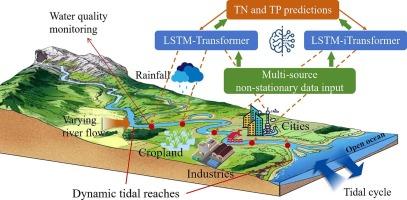Dual-model LSTM-Transformer framework with hydrodynamic adaptability for TN/TP predictions in tidal reaches
IF 6.3
1区 地球科学
Q1 ENGINEERING, CIVIL
引用次数: 0
Abstract
The accurate prediction of total nitrogen (TN) and total phosphorus (TP) concentrations is crucial for mitigating eutrophication and supporting sustainable water resource management in tidal estuaries. However, the highly non-stationary dynamics of TN/TP concentrations—characterized by time-varying patterns driven by complex river-tide interactions and biogeochemical cycling—pose significant prediction challenges. While deep learning models like LSTM and Transformer have advanced water quality forecasting, their standalone applications struggle to simultaneously capture long-term dependencies, cross-variable relationships, and hydrodynamic drivers in tidal systems. To address these limitations, we developed a framework that integrates LSTM with Transformer (LSTM-Transformer, LT) and iTransformer (LSTM-iTransformer, LIT), incorporating river discharge (RD), tidal level (TL), rainfall, water temperature (Temp), and PH as key input features. Evaluated across nine sites spanning 600 km of the Yangtze River tidal reach, the dual-model framework demonstrates superior performance over baseline models (LSTM, Transformer, CNN-LSTM), achieving an average RMSE reduction of 32.6 % (range: 16.7–57.1 %). The LT—combining LSTM’s temporal memory with Transformer’s global attention—excels in river-dominated and tide-dominated zones. Meanwhile, the LIT, enhanced through inverted feature embedding, outperforms in transitional zones by resolving short-term variability and cross-parameter interactions. SHAP analysis quantitatively validates hydrodynamic drivers (RD and TL) as critical predictive factors. This study provides a robust modeling solution for TN/TP prediction in tidal reaches, addressing the urgent need for accurate forecasting to enable early pollution warnings and informed water management decisions.

具有水动力适应性的双模型LSTM-Transformer框架用于潮汐河段的TN/TP预测
准确预测潮汐河口总氮(TN)和总磷(TP)浓度对缓解富营养化和支持可持续水资源管理具有重要意义。然而,TN/TP浓度的高度非平稳动态(以复杂的河流-潮汐相互作用和生物地球化学循环驱动的时变模式为特征)给预测带来了重大挑战。虽然LSTM和Transformer等深度学习模型具有先进的水质预测技术,但它们的独立应用很难同时捕捉潮汐系统中的长期依赖关系、交叉变量关系和水动力驱动因素。为了解决这些限制,我们开发了一个将LSTM与变压器(LSTM-Transformer, LT)和ittransformer (LSTM- ittransformer, LIT)集成在一起的框架,将河流流量(RD)、潮汐水位(TL)、降雨量、水温(Temp)和PH值作为关键输入特征。通过对长江潮汐段600公里9个站点的评估,双模型框架比基线模型(LSTM、Transformer、CNN-LSTM)表现出优异的性能,平均RMSE降低32.6%(范围:16.7 - 57.1%)。LSTM结合了LSTM的时间记忆和变形金刚的全局注意力,在河流主导区和潮汐主导区表现优异。同时,通过反向特征嵌入增强的LIT通过解决短期变异性和跨参数相互作用在过渡区表现优异。SHAP分析定量验证了流体动力驱动因素(RD和TL)是关键的预测因素。该研究为潮汐河段的TN/TP预测提供了一个强大的建模解决方案,解决了准确预测的迫切需要,从而实现早期污染预警和明智的水管理决策。
本文章由计算机程序翻译,如有差异,请以英文原文为准。
求助全文
约1分钟内获得全文
求助全文
来源期刊

Journal of Hydrology
地学-地球科学综合
CiteScore
11.00
自引率
12.50%
发文量
1309
审稿时长
7.5 months
期刊介绍:
The Journal of Hydrology publishes original research papers and comprehensive reviews in all the subfields of the hydrological sciences including water based management and policy issues that impact on economics and society. These comprise, but are not limited to the physical, chemical, biogeochemical, stochastic and systems aspects of surface and groundwater hydrology, hydrometeorology and hydrogeology. Relevant topics incorporating the insights and methodologies of disciplines such as climatology, water resource systems, hydraulics, agrohydrology, geomorphology, soil science, instrumentation and remote sensing, civil and environmental engineering are included. Social science perspectives on hydrological problems such as resource and ecological economics, environmental sociology, psychology and behavioural science, management and policy analysis are also invited. Multi-and interdisciplinary analyses of hydrological problems are within scope. The science published in the Journal of Hydrology is relevant to catchment scales rather than exclusively to a local scale or site.
 求助内容:
求助内容: 应助结果提醒方式:
应助结果提醒方式:


